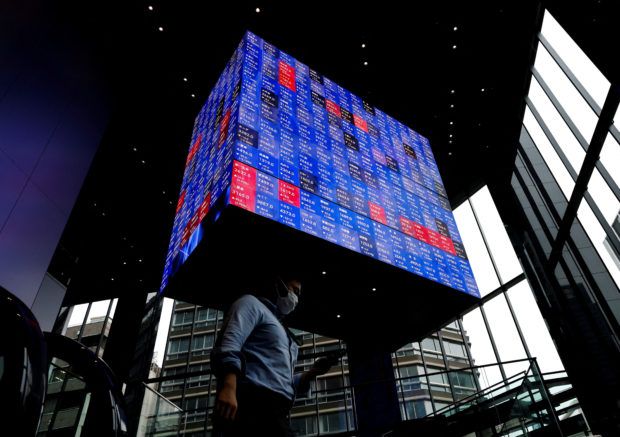Uneasy calm descends after SVB-triggered turmoil

A man walks under an electronic screen showing Japan’s Nikkei share price index inside a conference hall in Tokyo, Japan June 14, 2022. REUTERS/Issei Kato/File photo
LONDON – An uneasy calm descended on world markets on Wednesday, with efforts by regulators and financial executives to ease contagion fears sparked by the collapse of Silicon Valley Bank (SVB) shoring up sentiment.
But in a week that has seen banking shares around the world tank – the S&P 500 regional banks index has slid 18 percent – the mood remained fragile.
The European Central Bank is still leaning toward a half-percentage-point rate hike on Thursday, despite turmoil in the banking sector, given high inflation, a source close to its Governing Council told Reuters.
A reminder that major central banks remain in rate-hiking mode pushed government bond yields higher, while focus turned to British finance minister Jeremy Hunt’s budget later on.
ECB likely to stick to big rate hike despite banking turmoil, source says
“Many of the ingredients are there for sentiment to recover but only time will tell if this lasts,” said ING senior rates strategist Antoine Bouvet.
European stocks slipped 0.9 percent in early trade but held above three-month lows reached on Monday as panic gripped world markets following SVB’s collapse last week.
Asian equities rose, tracking Tuesday’s relief rally on Wall Street after U.S. inflation data delivered no nasty surprises, reinforcing hopes the Federal Reserve will go for a smaller rate hike when it meets next week.
MSCI’s broadest index of Asia-Pacific shares outside Japan rose 0.9 percent, having slid 1.7 percent on Tuesday. Japan’s Nikkei index was flat while an index of Japanese banks, which has slid 8 percent this week, jumped over 3 percent.
U.S. equity futures were mostly negative, suggesting a soft start for Wall Street.
Bruised U.S. bank stocks regained some ground on Tuesday aided by news that private equity and buyout giants were looking to scoop up some of SVB’s assets. That left investors hopeful that efforts to shore up confidence would avert a wider financial crisis.
Back to central banks
Data on Tuesday showed U.S. consumer prices rose 0.4 percent, with a year-on-year gain of 6 percent – in line with analyst expectations. There had been worries that stronger-than-expected data might lead the Fed to go for jumbo-sized hikes to battle inflation.
US consumer inflation still elevated as Fed comes under stress
As recently as last week, markets were braced for the return of large Fed interest rate rises but the swift collapse of SVB has changed those expectations, with markets pricing in an 80% chance of a 25 basis point hike next week.
Also helping boost sentiment was data showing China’s economic activity picked up in the first two months of the year, driven by consumption and infrastructure investment, and signs the beleaguered property sector is starting to recover.
In Europe, where markets had also rapidly dialled back ECB rate-hike bets at the start of the week, traders were betting again on a big increase in euro zone borrowing costs on Thursday.
According to a Reuters report, a source close to the ECB Governing Council said the central bank was unlikely to ditch plans for a big rate move this week because that would damage its credibility.
“The ECB is behind (the U.S. Federal Reserve) in terms of a tightening cycle and has a lot to do,” said Jorge Garayo, senior rates and inflation strategist at Societe Generale.
“Core inflation,” he added, “is still at very, very elevated levels. So we will be very surprised to not see 50 basis points delivered by the ECB.”
Short-term bond yields, which typically move in step with interest rate expectations, were mixed on Wednesday.
Germany’s two-year yield was down 3 bps at 2.89 percent, having fallen to as low as 2.43 percent briefly on Tuesday.
The two-year U.S. Treasury yield was up 10 bps at 4.33 percent, well off Tuesday’s six-month low of 3.83 percent.
In currency markets, the dollar index, which measures the U.S. currency against six rivals, was flat at 103.74, with the euro also mostly steady at $1.0735.
Oil prices rebound after OPEC upgrades China demand outlook
Oil prices rebounded more than 1 percent, coming back from three-month lows the previous session, due to a stronger OPEC outlook on China’s demand. Brent crude futures climbed 1.6% to $78.68 a barrel. U.S. West Texas Intermediate crude futures (WTI) gained 1.6 percent to $72.48.